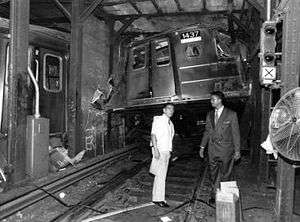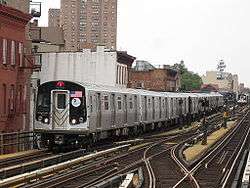1991 Union Square derailment
 The damaged R62 car at the site of the accident | |
| Date | August 28, 1991 |
|---|---|
| Time | 12:12 a.m. |
| Location | North of 14th Street–Union Square |
| Coordinates | 40°44′10″N 73°59′22″W / 40.73602°N 73.98952°WCoordinates: 40°44′10″N 73°59′22″W / 40.73602°N 73.98952°W |
| Country | United States |
| Rail line | IRT Lexington Avenue Line |
| Operator | New York City Transit Authority |
| Type of incident | Derailment |
| Cause | Intoxication, driver error, overspeeding |
| Statistics | |
| Trains | 1 |
| Passengers | 216 |
| Deaths | 5 |
| Injuries | 161 (16 seriously) |
Shortly after midnight on August 28, 1991, a New York City Subway train on the IRT Lexington Avenue Line derailed as it was about to enter 14th Street–Union Square. Five people were killed. It was the worst accident on the subway system since the 1928 Times Square derailment. The motorman was found at fault for intoxication and excessive speed, and served time in prison for manslaughter.
Accident
During the night of August 27–28, 1991, there was construction on the IRT Lexington Avenue Line that required southbound express trains to switch to the local track. This required trains to slow down to 10 miles per hour (16 km/h) before using the switch. This maneuver involved going through a "pocket track," a track between the southbound local and express tracks, which was used in order to hold trains that were using the switch without delaying local and express trains that were not going through the switch.[1] At about 12:12 a.m. on August 28, 1991, a ten-car 4 Lexington Avenue Express train, heading southbound with approximately 216 passengers, derailed at the pocket track as it was about to enter 14th Street–Union Square.[2] The train was traveling at as much as 50 miles per hour (80 km/h), too fast for the line's train stops to derail the train in time.[3][4]
Five people died, all almost immediately.[2] Several support columns were destroyed, causing the street above to immediately subside by 0.5 inches (1.3 cm).[5] It was the deadliest subway accident to happen in New York City since the Times Square disaster of 1928.[3][6]
The first car, #1440, which struck a steel pillar,[2][5][7] was cut in half and had its roof sheared off, but its motorman's cab was not damaged.[8] The second, #1439, folded in half by the barrier between the express and local tracks.[8] Car #1437 was split in half and folded around a support beam, and cars #1436 and #1435 were also seriously damaged.[2][5][7] The cars lay tangled in between the support beams.[8] The train was damaged so badly that one emergency responder said that he "couldn't even tell where one car ended and another began at some points."[8]
Rescue, investigation, and trial
The accident occurred within earshot of the Transit Police command post in the Union Square station, and within the sight of two Transit Police officers waiting on the platform,[9] and response was rapid. The accident location was very close to the platform, which was used for triage, and field treatment took place on the upper level of the station.[2] Working conditions at the site were very cramped and hot, and it took until 3:15[2] or 3:45[9] to extract the last passenger. In total, 121 passengers and 24 emergency responders were taken to hospitals; 16 passengers were injured seriously enough to be admitted.[2] Debris was found as far away as 150 feet (46 m) from the lead car.[8]
The motorman, Robert E. Ray, later said that he had drunk heavily the day before his work shift and had fallen asleep at the time of the accident.[3][10] He was not hurt in the crash, so he walked into the station and identified himself, then sat on a park bench during the rescue operation.[3] The NYPD later reported that he drank three beers after the accident.[8] He was arrested at 5:30 while returning to his apartment building, and when tested approximately 13 hours after the accident, his blood alcohol level was 0.21;[3] the legal level in New York State was 0.10 at the time.[8] Ray later told the police that he had been drinking all day at the time of the accident because he was depressed that his ex-girlfriend would not let him see their two children.[8]
At his trial it was established that he had overshot the platforms at several stations in the Bronx and had not braked approaching 14th Street–Union Square.[11] One passenger, Jerry Yambl, stated that prior to the crash, Ray had "let two cars from the front pass the platform and opened the doors. But there was nothing, no platform." Another passenger, Olalekan Ogundele, said, "This guy never slowed down" during the entire trip.[8] Prior to the crash, both the conductor and an off-duty NYCTA employee had advised Ray to reduce the train's speed.[8]
On October 15, 1992, a jury acquitted him of murder but found him guilty of five counts of second-degree manslaughter,[11][12] and on November 6 he was sentenced to five to fifteen years in prison plus terms of between one and seven years for assault on 26 of the injured passengers, all to run concurrently.[13] He was released in April 2002.[14]
Aftermath
Service on the Lexington Avenue Line resumed six days after the accident, on September 3, after completion of the site investigation and four days of round-the-clock debris removal and construction work, including the Labor Day holiday.[15][16] The five R62 subway cars destroyed in the accident—the lead car, #1440, and four of the five following cars, #1435, #1436, #1437, and #1439—were scrapped.[7][note 1] In addition to the support columns, two sets of track, a third rail, two signal sets, two switches, and an air compressor room had been destroyed. The switches and tracks were rebuilt, with the NYCTA removing the "pocket track" on which the train had derailed and replacing it with a simple diamond crossover.[5]
Reporters at New York Newsday won the 1992 Pulitzer Prize for Spot News Reporting for their coverage of the accident.[17][18]
A 1992 study commissioned after the accident by the New York City Transit Authority found that some signals in the subway system, including several on the Lexington Avenue line, were spaced too closely for a train traveling at maximum speed to have time to stop, confirming the finding of safety investigators immediately after the crash; the issue resurfaced after a rear-end collision on the Williamsburg Bridge in 1995.[4][19][20] Ultimately, the accident also led to the phasing-in of communications-based train control and automated trains on the New York City Subway in the 21st century.[21][1]
See also
Notes
- ↑ Car #1438 was not seriously damaged, so it was later returned to service along with #1431–1434, the other four cars in the train. Car #1438 was converted from a non-driving trailer car, or "B" car, to a cab car, or "A" car, in the process.
References
- 1 2 Regional Plan Association, Moving Forward: Accelerating the Transition to Communications-Based Train Control for New York City's Subways, May 2014, p. 18 (pdf).
- 1 2 3 4 5 6 7 "Case Study Number Ten: Union Square Station, New York City—August 28, 1991", in: John Kimball and Hollis Stambaugh, Special Report: Rail Emergencies, Technical report series (United States Fire Administration) USFA-TR-094, [Emmitsburg, Maryland]: Federal Emergency Management Agency, U.S. Fire Administration, National Fire Data Center, [2003?], p. 27.
- 1 2 3 4 5 Robert D. McFadden, "Catastrophe Under Union Square; Crash on the Lexington IRT: Motorman's Run to Disaster", The New York Times, September 1, 1991.
- 1 2 "Probe Finds Subway's Speed Outstripped Safety System", The Washington Post, August 31, 1991 – via HighBeam (subscription required)
- 1 2 3 4 "Project Management in Practice: The Wreckmaster at a New York Subway Accident", in: Jack R. Meredith and Samuel J. Mantel Jr., Project Management: A Managerial Approach, 8th ed. Hoboken, New Jersey: Wiley, 2012, ISBN 9780470533024, pp. 115–17.
- ↑ Brian J. Cudahy, "Preface to the Second Revised Edition", Under the Sidewalks of New York: The Story of the Greatest Subway System in the World, 1979, 2nd rev. ed. New York: Fordham University, 1995, ISBN 9780585195254, p. ix.
- 1 2 3 "R-62 (Kawasaki) — R-62A (Bombardier)", nycsubway.org, retrieved May 27, 2014.
- 1 2 3 4 5 6 7 8 9 10 "N.Y. police say subway motorman was drunk; manslaughter charged" (PDF). Greenfield (Massachusetts) Recorder. Associated Press. 1991-08-29. Retrieved 2016-09-13 – via Fultonhistory.com.
- 1 2 James C. MacKinley Jr., "Trapped Riders Saved in Team Effort", The New York Times Book of New York: 549 Stories of the People, the Events, and the Life of the City—Past and Present, ed. James Barron, New York: Black Dog & Leventhal, 2009, ISBN 9781579128012, p. 69.
- ↑ "Nation & World: Newsmaker", The Milwaukee Journal, September 1, 1991, p. J1.
- 1 2 "Subway motorman found guilty of manslaughter", Sarasota Herald-Tribune, October 16, 1992, p. 14A.
- ↑ Laurie Goodstein, "New York Motorman Convicted of Manslaughter; Subway Employee Cleared of Murder Charges in Train Wreck That Killed Five Last Year", The Washington Post, October 16, 1992 – via HighBeam (subscription required)
- ↑ Ronald Sullivan, "Motorman Gets 5 to 15 Years in Crash", The New York Times, November 7, 1992.
- ↑ "Flashback: Revisiting The Worst Train Derailments In NYC History", Gothamist, December 23, 2012.
- ↑ Calvin Sims, "Subway Line Back After Being Closed By Fatal Derailing", The New York Times, September 3, 1991.
- ↑ "Topics of The Times; After Tragedy, Teamwork", Opinion, The New York Times, September 6, 1991.
- ↑ "1992 Winners and Finalists", The Pulitzer Prizes.
- ↑ "1992 Pulitzer Prize Winners and Their Works in Journalism and the Arts", The New York Times, April 8, 1992.
- ↑ Richard Perez-Pena, "'92 Study Found Problems With Subway Stop Signals", The New York Times, June 21, 1995.
- ↑ Associated Press, "Operators not warned about signal problem", The Hour, June 22, 1995, p. 18.
- ↑ Justin Glanville, Associated Press, "Century-old New York subway gets a computerized makeover", The Hour, April 11, 2005, p. A18.




